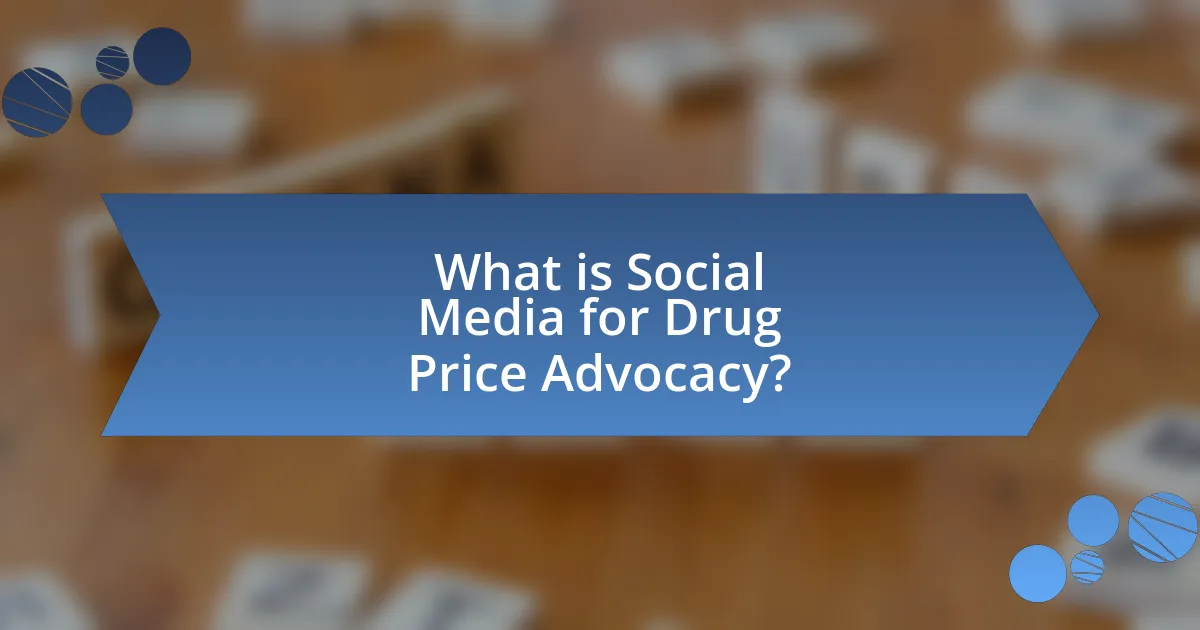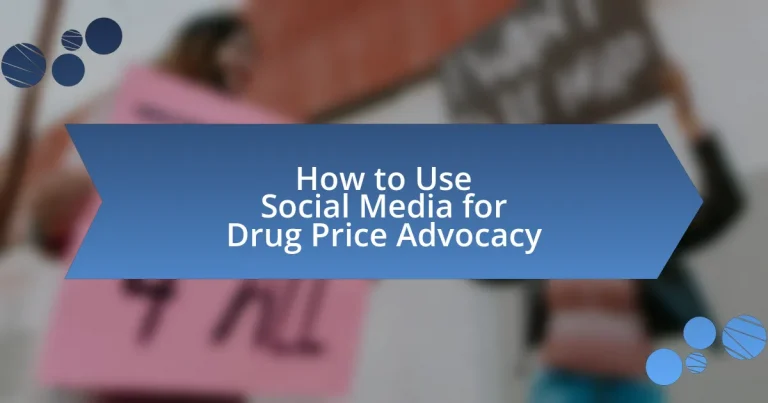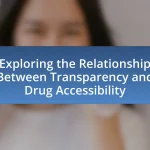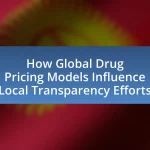Social media for drug price advocacy involves utilizing platforms such as Twitter, Facebook, and Instagram to raise awareness and mobilize support for reducing high prescription drug prices. The article outlines effective strategies for advocacy, including targeted messaging, storytelling, and the use of hashtags to enhance visibility. It discusses the impact of high drug prices on patients and healthcare systems, the importance of advocacy in promoting health equity, and the potential for social media campaigns to influence policy changes. Additionally, the article addresses challenges advocates may face, such as misinformation and privacy concerns, while providing best practices for engaging audiences and measuring advocacy success.

What is Social Media for Drug Price Advocacy?
Social media for drug price advocacy refers to the use of platforms like Twitter, Facebook, and Instagram to raise awareness and mobilize support for reducing high prescription drug prices. This approach enables individuals, organizations, and activists to share information, personal stories, and data that highlight the financial burden of expensive medications. For instance, campaigns such as #PharmaBro and #DrugPricesTooHigh have gained traction, illustrating public frustration and prompting discussions about policy changes. Social media’s broad reach allows advocates to connect with a larger audience, influencing public opinion and potentially impacting legislative actions related to drug pricing.
How can social media be utilized in advocating for drug price changes?
Social media can be utilized in advocating for drug price changes by mobilizing public support, raising awareness, and facilitating direct communication between advocates and policymakers. Platforms like Twitter and Facebook allow users to share personal stories about the impact of high drug prices, which can humanize the issue and garner empathy. For instance, campaigns such as #PharmaBro and #FairPrice have successfully highlighted the struggles of individuals facing exorbitant medication costs, leading to increased media coverage and public discourse. Additionally, social media enables the organization of virtual events and petitions, amplifying collective voices that can influence legislative action. Research indicates that social media campaigns can significantly increase public engagement and pressure on decision-makers, as seen in the advocacy efforts surrounding the Affordable Care Act.
What platforms are most effective for drug price advocacy?
Social media platforms such as Twitter, Facebook, and Instagram are most effective for drug price advocacy. These platforms enable advocates to reach a broad audience, engage in real-time discussions, and mobilize support for policy changes. For instance, Twitter’s character limit encourages concise messaging, making it ideal for sharing impactful statistics and calls to action, while Facebook allows for more detailed storytelling and community building around drug pricing issues. Additionally, Instagram’s visual content can effectively highlight personal stories and the human impact of high drug prices, fostering empathy and awareness.
How does social media influence public perception of drug pricing?
Social media significantly influences public perception of drug pricing by facilitating the rapid dissemination of information and personal experiences related to medication costs. Platforms like Twitter and Facebook allow users to share stories about high drug prices, which can lead to increased awareness and outrage among the public. For instance, a study published in the Journal of Medical Internet Research found that social media discussions about drug pricing often highlight personal anecdotes, which can evoke emotional responses and shape collective opinions. This amplification of individual experiences can pressure policymakers and pharmaceutical companies to address pricing issues, as public sentiment becomes more vocal and organized through online campaigns.
Why is drug price advocacy important?
Drug price advocacy is important because it aims to ensure affordable access to essential medications for all individuals, particularly those in vulnerable populations. High drug prices can lead to medication non-adherence, resulting in worsened health outcomes and increased healthcare costs. For instance, a study published in the Journal of the American Medical Association found that nearly 25% of Americans reported not filling a prescription due to cost, highlighting the critical need for advocacy efforts to address pricing disparities. By raising awareness and influencing policy changes, drug price advocacy plays a vital role in promoting health equity and improving public health overall.
What impact do high drug prices have on patients and healthcare systems?
High drug prices significantly burden patients and healthcare systems by limiting access to necessary medications and increasing overall healthcare costs. Patients often face financial hardship, leading to medication non-adherence, which can exacerbate health conditions and result in higher long-term healthcare expenses. For instance, a study published in the Journal of the American Medical Association found that nearly 25% of Americans reported not filling a prescription due to cost, indicating a direct impact on patient health outcomes. Additionally, healthcare systems experience increased strain as untreated conditions lead to more emergency room visits and hospitalizations, ultimately driving up costs for providers and insurers.
How can advocacy lead to policy changes in drug pricing?
Advocacy can lead to policy changes in drug pricing by mobilizing public support and influencing lawmakers to prioritize reforms. When advocacy groups utilize social media platforms, they can effectively raise awareness about high drug prices, share personal stories, and disseminate information that highlights the need for change. For instance, campaigns like #PharmaBro and #FairDrugPrices have successfully garnered attention, leading to legislative proposals aimed at regulating drug costs. Research indicates that public pressure from advocacy efforts can result in significant shifts in policy, as seen in the 2021 introduction of the Affordable Drug Pricing Act, which aimed to lower prescription drug prices in the United States.

What strategies can be employed for effective advocacy on social media?
Effective advocacy on social media can be achieved through targeted messaging, audience engagement, and data-driven campaigns. Targeted messaging involves crafting clear, concise, and compelling content that resonates with specific demographics, ensuring that the message aligns with the interests and values of the audience. Audience engagement is crucial; actively responding to comments, sharing user-generated content, and fostering community discussions can enhance trust and support. Data-driven campaigns utilize analytics to track engagement metrics, allowing advocates to refine their strategies based on what resonates most with followers. For instance, a study by the Pew Research Center found that 69% of adults in the U.S. use social media, highlighting its potential reach for advocacy efforts.
How can storytelling enhance drug price advocacy efforts?
Storytelling can enhance drug price advocacy efforts by creating emotional connections that resonate with audiences, thereby increasing engagement and support. When advocates share personal narratives about the impact of high drug prices on individuals and families, they humanize the issue, making it more relatable and urgent. Research indicates that emotional storytelling can lead to a 50% increase in message retention and a 30% increase in the likelihood of action among audiences. This effectiveness is rooted in the ability of stories to evoke empathy, prompting listeners to consider the real-life implications of drug pricing policies.
What are the key elements of a compelling advocacy story?
A compelling advocacy story includes a clear message, relatable characters, emotional appeal, and a call to action. The clear message articulates the issue at hand, such as the impact of high drug prices on individuals and families. Relatable characters, often real people affected by the issue, help the audience connect emotionally. Emotional appeal engages the audience’s feelings, making them more likely to empathize with the cause. Finally, a strong call to action motivates the audience to take specific steps, such as sharing the story on social media or contacting policymakers. These elements work together to create a narrative that resonates and drives advocacy efforts effectively.
How can personal experiences be shared effectively on social media?
Personal experiences can be shared effectively on social media by using storytelling techniques that engage the audience emotionally. Engaging narratives that include specific details about the experience, such as challenges faced and outcomes achieved, resonate more with viewers. Research indicates that posts with personal stories receive 300% more engagement than standard updates, highlighting the importance of relatability and authenticity in communication. Additionally, incorporating visuals, such as images or videos, enhances the impact of the message, as posts with visuals are known to be shared 40 times more than those without.
What role do hashtags and campaigns play in advocacy?
Hashtags and campaigns serve as essential tools in advocacy by amplifying messages and mobilizing support. They create a unified voice around specific issues, making it easier for individuals to find and engage with relevant content. For instance, the hashtag #PharmaBro was used to raise awareness about drug pricing issues, leading to increased public discourse and media coverage. Campaigns often leverage these hashtags to organize events, share information, and encourage collective action, thereby enhancing visibility and impact. Research indicates that social media campaigns utilizing targeted hashtags can significantly increase engagement rates, as seen in the #MeToo movement, which effectively highlighted issues of sexual harassment and assault.
How can specific hashtags increase visibility for drug price issues?
Specific hashtags can increase visibility for drug price issues by categorizing content, making it easily discoverable by users interested in that topic. When users employ targeted hashtags like #DrugPrices or #PharmaTransparency, they connect their posts to broader conversations, enhancing engagement and reach. Research indicates that posts with relevant hashtags can receive up to 12.6% more engagement than those without, demonstrating the effectiveness of this strategy in raising awareness about drug pricing concerns.
What are some successful campaigns that have influenced drug pricing?
Successful campaigns that have influenced drug pricing include the “#PharmaBro” campaign against Martin Shkreli, which raised public awareness about price gouging when he increased the price of the life-saving drug Daraprim by over 5,000%. This campaign led to significant media coverage and public outrage, prompting discussions on drug pricing reform. Another notable campaign is the “Patients for Affordable Drugs” initiative, which advocates for lower drug prices and has successfully lobbied for legislative changes, including the introduction of bills aimed at reducing prescription drug costs. These campaigns have effectively mobilized public opinion and influenced policymakers to address drug pricing issues.

What challenges might advocates face on social media?
Advocates face several challenges on social media, including misinformation, algorithm biases, and limited audience reach. Misinformation can undermine advocacy efforts, as false narratives about drug prices can spread rapidly, leading to public confusion. Algorithm biases may limit the visibility of advocacy posts, making it difficult for advocates to reach their target audience effectively. Additionally, the fragmented nature of social media platforms can hinder cohesive messaging, as different platforms attract varying demographics and engagement levels. These challenges necessitate strategic approaches to ensure that advocacy messages are clear, accurate, and widely disseminated.
How can misinformation affect drug price advocacy?
Misinformation can significantly undermine drug price advocacy by creating confusion and distrust among the public and policymakers. When inaccurate information circulates, it can lead to misguided perceptions about the necessity and fairness of drug pricing, ultimately hindering efforts to promote transparency and affordability. For instance, a study by the Pew Research Center found that 64% of Americans believe misinformation has a major impact on public opinion, which can skew support for necessary reforms in drug pricing. This distortion can result in reduced advocacy effectiveness, as stakeholders may focus on debunking false claims rather than addressing the actual issues surrounding drug costs.
What strategies can be used to combat misinformation?
To combat misinformation, strategies include fact-checking, promoting media literacy, and utilizing transparent communication. Fact-checking organizations, such as Snopes and FactCheck.org, verify claims and provide accurate information, helping to dispel false narratives. Promoting media literacy equips individuals with the skills to critically evaluate sources and discern credible information from misinformation. Transparent communication from trusted sources, including health organizations and government agencies, fosters trust and reduces the spread of false information. These strategies collectively enhance public understanding and mitigate the impact of misinformation in contexts like drug price advocacy on social media.
How can advocates ensure their messages are credible and trustworthy?
Advocates can ensure their messages are credible and trustworthy by using verified data and reputable sources to support their claims. For instance, citing studies from recognized institutions, such as the National Institutes of Health or peer-reviewed journals, enhances the reliability of the information presented. Additionally, advocates should engage with experts in the field to validate their messages, ensuring that the content reflects accurate and current knowledge. Transparency about the sources of information and the methodology used to gather data further strengthens credibility, as seen in successful campaigns that reference specific statistics or case studies to illustrate their points.
What are the potential risks of using social media for advocacy?
The potential risks of using social media for advocacy include misinformation, backlash from opposing groups, and privacy concerns. Misinformation can spread rapidly on social media platforms, leading to confusion and undermining the credibility of advocacy efforts. For instance, a study by the Pew Research Center found that 64% of Americans believe that misinformation is a major problem on social media. Backlash from opposing groups can result in targeted harassment or coordinated attacks against advocates, which can deter individuals from participating in advocacy. Additionally, privacy concerns arise when personal information is shared online, potentially exposing advocates to risks such as doxxing or unwanted attention. These risks highlight the need for careful strategy and risk management in social media advocacy.
How can advocates protect their privacy and safety online?
Advocates can protect their privacy and safety online by utilizing strong privacy settings on social media platforms, employing secure communication tools, and being cautious about the information they share. Strong privacy settings limit who can view posts and personal information, while secure communication tools, such as encrypted messaging apps, help protect sensitive discussions. Additionally, advocates should avoid sharing identifiable information, such as their location or personal details, to minimize risks. According to a study by the Electronic Frontier Foundation, using these strategies significantly reduces the likelihood of online harassment and data breaches, thereby enhancing overall safety for advocates.
What are the consequences of backlash from pharmaceutical companies?
Backlash from pharmaceutical companies can lead to significant consequences, including increased scrutiny from regulators, public relations challenges, and potential legislative changes. When pharmaceutical companies face backlash, such as from social media campaigns advocating for lower drug prices, they may encounter heightened regulatory oversight as government agencies respond to public concerns. This scrutiny can result in stricter compliance requirements and potential penalties for non-compliance. Additionally, negative public sentiment can damage a company’s reputation, leading to loss of consumer trust and decreased sales. For instance, the backlash against price hikes for certain medications has prompted legislative proposals aimed at regulating drug pricing, demonstrating how public outcry can influence policy changes.
What best practices should advocates follow on social media?
Advocates should prioritize authenticity, engagement, and strategic messaging on social media. Authenticity builds trust; sharing personal stories or experiences related to drug pricing can resonate with audiences and foster connections. Engagement is crucial; responding to comments and participating in discussions can enhance visibility and strengthen community ties. Strategic messaging involves clearly articulating goals and using data to support claims, such as referencing studies that highlight the impact of high drug prices on public health. For instance, a report by the House of Representatives in 2019 indicated that nearly one in four Americans reported not filling a prescription due to cost, underscoring the urgency of advocacy efforts.
How can advocates effectively engage with their audience?
Advocates can effectively engage with their audience by utilizing targeted messaging and interactive content on social media platforms. By tailoring their messages to address specific concerns and interests of their audience, advocates can foster a sense of community and encourage participation. Research indicates that posts with questions or calls to action generate higher engagement rates, with a study showing that interactive content can increase audience interaction by up to 70%. Additionally, using data-driven insights to understand audience demographics and preferences allows advocates to refine their strategies, ensuring that their outreach is both relevant and impactful.
What are the key metrics to measure the success of advocacy efforts?
Key metrics to measure the success of advocacy efforts include engagement rates, reach, conversion rates, and policy impact. Engagement rates reflect how actively the audience interacts with advocacy content, indicating interest and support. Reach measures the number of individuals exposed to the advocacy message, essential for understanding the campaign’s visibility. Conversion rates assess the effectiveness of calls to action, showing how many individuals took desired actions, such as signing petitions or contacting legislators. Lastly, policy impact evaluates changes in legislation or public policy resulting from advocacy efforts, providing a concrete measure of success. These metrics collectively offer a comprehensive view of advocacy effectiveness in driving awareness and influencing change.


